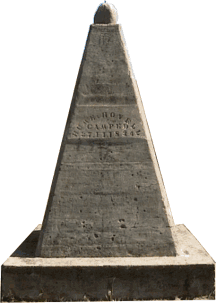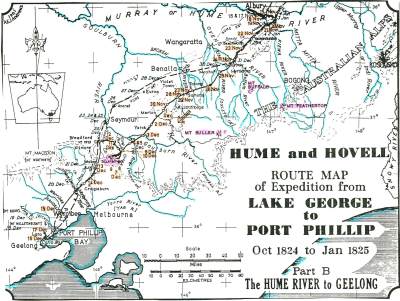In 1824 Hamilton Hume and William Hilton Hovell, encouraged by Governor Brisbane, led an expedition of six convict servants overland to reach the Southern coast. (Map)
A fortnight after leaving Hume's home at Appin, the party left his station at Gunning, on October 17th 1824, with five bullocks, three horses and two carts. (They took the carts as far as the Goodradigbee River, near Wee Jasper. I wonder what became of them?)
They were the first whites know to see what we call the Murray River; they christened it the Hume River for Hamilton Hume's father. However in 1830 Captain Charles Sturt, not realising he was the same river Hume and Hovell had encountered upstream, named the Murray River in honour of the then British Secretary of State for War and the Colonies, Sir George Murray. The name Murray stuck.
Arriving at the river, Hume & Hovell each carved their name into separate trees. Hamilton Hume's tree was burnt down in fires in the 1840. William Hovell's tree survives to date of writing, despite a termite attack, and in 2013 a clone of it was planted at Tatong.
Hume & Hovell arrived at Corio Bay on December 16th 1824.
Hovell miscalculated at the end, and they thought they were at Westernport.
They crossed South Eastern part of the present shire of Benalla, and on the evening Saturday 27th November camped by Hollands Creek.

A monument by the Tolmie road, 7km South of Tatong, is near the place they are thought to have camped.
On Sunday 28th they climbed ‘Sunday Mount’, thought to be the hill immediately north of Samaria, overlooking Dodd’s Crossing at Fern Hills, South of Tatong.
They then crossed Samaria Creek and camped by the Broken River, which they called the ‘Swampy’, and the land about it ‘Norton's Meadows’
Below are some extracts from “Journey of Discovery to Port Phillip”.
Their successful trip generated reports of hundreds of miles of good grazing land, well-watered and with a good climate. Many pastoralists began to move into this new territory. (That other people already occupied the land was not considered relevant. They weren't British.) John Batman formed the Port Phillip Association to investigate the area.
White settlers began to occupy the mainland west and north of Port Phillip; the Henty brothers settled at Portland in 1834. The authorities in Sydney were not keen, but in 1836 Governor Bourke approved the settlement by the Yarra, named it Melbourne and instructed the surveyor Robert Hoddle to lay out a township so that land sales could be held.
Pastoralists in New South Wales began in 1837 to move their stock across the Murray. They spread out along the tributaries of the Murray, stopping when they found an area they liked, until by 1840 almost all the open country north of the Great Dividing Range as far west as the Campaspe River was occupied.



